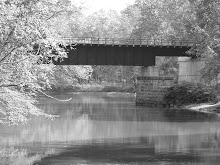Bridge Fencing And Berea Sandstone
The first round of federal stimulus dollars for local infrastructure projects have been announced and the complaints about government waste are already materializing. One of those projects, The Akron Y Bridge rehabilitation, includes installation of safety fencing along the bridge. The decision to fence the bridge has been batted around since several citizens have decided to jump to their deaths from the span. The cost has always been prohibitive until now.
Needed as it may be may be there is an undertone of criticism swirling around the inclusion of the fencing within the bridge project. Tim over at the Chief Source has some misgivings about the waste aspect of spending money on the fence. I Think he's mad about the diminution of the view. Grumpy Abe points out that the ABJ headline on the project implies there is a groundswell of dissatisfaction over the fence even though none really exists. To not be outdone I found a story on Topix from the International Herald Tribune that refers to federal stimulus dollars being spent on "anti-suicide fencing" to keep people from jumping to their deaths.
I can already see where these complaints are going. The Tea Party crowd will get a hold of these project names and individual components and turn them into anti-government invectives. All of this misses the point of the federal program. The dollars are being dedicated to local projects and those projects are being designed and planned by local governments. The overarching goals being to invest in infrastructure and employ people. This isn't a contest to see who can create the most spartan bridge deck.
The current federal funding program for roads and bridges is very similar to the Depression era programs of the 1930's that also had this dual purpose. The evidence of those historical initiatives can be seen all over the Cuyahoga Valley in the form of sandstone blocks that ring the parking lots and mark the park roads. All of these blocks were harvested from the local quarries as part of a program to improve the amenities of the park and keep your grandfather employed. Consider this passage describing a popular location in the Cuyahoga Valley National Park that benefited from the Depression era jobs program:
The Civilian Conservation Corps (CCC) accomplished much of the early work of transforming the private retreat into a public park. Structures in the park built by the CCC in the 1930s include Kendall Lake itself, completed in 1935 and built primarily for swimming, toboggan chutes in 1936 (later removed by the National Park Service), the Lake Shelter in 1937, originally used as a swimmers bathhouse and concession, and the unique chestnut wood privies.
That description was from the Trail Guide Cuyahoga Valley National Park, 3rd Edition. A critic of Roosevelt CCC's work could have been inclined to doubt the need for fancy wood outhouses and a swimming lake. Sure, the country was facing economic collapse and the government was paying men to build recreational digs out out of expensive materials.
The point back then was the same as it is with today's stimulus program spending. The country is facing a great economic decline, one that is chiefly demand driven. The point of infrastructure spending in 2009 is to employee people, drive up demand and get the national economy back on its feet. Not much different than in the 1930's.
Bridge fencing as part of an overall project to rehab an elevated roadway is not a far cry from those sandstone blocks that ring the parking lots or adorn the shelters in the CVNP. Why quarry large chunks of sandstone only to bury them halfway in the ground near park roadways? Why install unsightly fencing along the entire length of Akron's most notable bridge? The answer for both questions is the same. These projects were sanctioned to employ Ohioans and improve our infrastructure in the process. Whether it be park roads or city thoroughfares.
Some critics will be hanging on the the name and intent of every infrastructure project that gets tapped for stimulus funding. In the case of the Y Bridge the image of government waste will be intimated because the $1.5 million spent on the fencing will be puffed up to hyperbolic levels by every libertarian or anti-taxer in throwing distance.
I'd argue that the view was not the driving force (get it) behind the funding of the Y Bridge project. The City of Akron had a duel need of investing in infrastructure and uplifting the economic well being of the region. Directing the federal dollars towards a comprehensive design for revamping the bridge happens to include the maligned "suicide fencing" among other improvements.
You can argue that the views from the Y Bridge will be diminished once the fences go up, but don't tell me that it's a waste of money. Losing the unobstructed view from the bridge is a small price for building a safe and structurally sound piece of Akron's infrastructure. If you want to take in a vista of the surrounding terrain I would suggest the outlook trail at Kendall Ledges. While you're in the area stop by Kendall Lake and check out the Berea sandstone road markers and the stone lodge that sits alongside that lake.











No comments:
Post a Comment